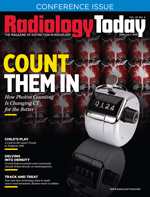 Ultrasound News: Less Hand Wringing
Ultrasound News: Less Hand Wringing
By Jennifer Meade
Radiology Today
Vol. 23 No. 4 P. 32
Improved ultrasound ergonomics help reduce workplace injuries and optimize patient throughput.
The United States Bureau of Labor Statistics estimates the demand for sonographers will grow by 14% through 2030, with an estimated 12,000 open sonographer positions each year.1 As hiring demands grow, hospitals can differentiate themselves by providing their sonographers with technologies that improve workflow and comfort.
Sonographers image patients for eight to 10 hours per day, and repetitive motions and strains have been shown to lead to injuries. In 2018, the Society of Diagnostic Medical Sonography estimated that about 90% of sonographers experience work-related musculoskeletal disorders.2 Upper limb pain and back pain are two of the most common pains for ultrasound practitioners.
Ultrasound device manufacturers are continuously seeking to improve the ergonomics of their devices in order to make them more intuitive and quicker to use on a daily basis, while reducing work-related injuries. Today’s systems have moved beyond lightweight transducers to meet the unique needs of ultrasound teams. Everything from limiting wrist movements to reducing machine noise can play a role in the health of the sonography team, and many systems have started to address these issues through innovative designs that reduce the number of knobs and buttons, improve screen adjustability, and deliver an overall quieter system.
Design for Customization
Medical technology companies continue to advance their ultrasound systems to meet the ergonomic needs of sonographers. The latest technology embraces innovative designs informed by customer feedback and surveys to address the areas where sonographers voiced the most concerns. This feedback has highlighted one clear takeaway: the need for customization.
One area of emphasis is reducing hand and wrist movements through the reduction and customization of buttons and knobs. A well-designed ultrasound system supports the sonographer’s wrist and limits movement, in order to reduce injury risk. Nearly 10 years ago, many systems had more than 50 buttons that sonographers needed to utilize for imaging. Designs today perform the same functions with only 15 buttons and knobs. Additionally, these buttons can be rearranged on the control panel to make it fully customizable to each ultrasound team, improving workflow.
In order to further reduce injuries for this area of the body, some models now utilize a trackpad control system over the traditional track ball. A sonographer no longer needs to round their hand on a trackball all day or clean the water-based gel from around its base. Similar to a smartphone interface, the trackpad simplifies the on-screen selection process. The trackpad allows for easy movements and selection, so sonographers can focus more on the patient rather than the machine.
Another common concern from sonographers is the ability to move the monitor and control panel to accommodate their height needs, as well as those of their patients. Older models utilize a center axis for the monitor and a control panel to move around, but do not adjust up or down, left or right. This can cause sonographers to stand in awkward positions, as they attempt to image a patient and manage the ultrasound system. The latest ergonomic designs enable sonographers to manipulate the monitor and control panel to adjust in nearly any direction, to help meet their working style and height while also accommodating patient positioning.
While customization is key for ergonomics, another concern is noise. Older machines are loud, and dealing with noise all day has a negative impact on sonographers’ work environment. Today’s machines have been updated to provide a quieter environment.
Together, these changes account for many of the ergonomic adaptations that have been made in recent years. However, there are still areas for improvement that medical technology companies are hoping to address in the years ahead.
Ergonomics in the Future
As ultrasound systems continue to progress, allowing sonographers to manipulate equipment to fit their needs will remain a high priority. As one of the most operator-dependent imaging systems, ultrasound provides opportunities for unique user controls.
However, instead of focusing on hardware, the next evolution of ultrasound systems will likely include customizable software so each user can have their own settings. We anticipate that sonographers will log in under a unique username and password, which will have a user-specific configuration to the buttons and knobs. Whereas hardware currently dictates where and how each button is configured, the next phase of ultrasound will have stationary components that can be programmed for specific commands. When a user logs in, those saved settings will align with the buttons for a customized control panel that meets each sonographer’s ergonomic needs and preferences.
Additionally, there are opportunities for AI to expand in this imaging modality. AI offers the opportunity to reduce user fatigue and strain by optimizing the system and performance. By eliminating redundancies and automating settings, sonographers could potentially save time per patient and improve their workflow.
Ultrasound provides key insights into the human body, and sonographers play a critical role in health care delivery. The future of ultrasound innovation lies in optimizing and customizing the ultrasound user experience to prioritize streamlined, ergonomic, and intuitive functionality that fits the individualized needs of operators and health care facilities. By investing in ultrasound systems that work with sonographers to achieve the most effective and ergonomic workflow, health care facilities can attract and retain talent as the demand grows for professionals in the field.
— Jennifer Meade is the president of breast and skeletal health solutions at Hologic, Inc.
References
1. Medical sonographers and cardiovascular technologists and technicians: occupational outlook handbook. U.S. Bureau of Labor Statistics website. https://www.bls.gov/ooh/healthcare/diagnostic-medical-sonographers.htm#tab-1. Published October 21, 2021. Accessed April 5, 2022.
2. Society of Diagnostic Medical Sonography. Work related musculoskeletal disorders in sonography. https://www.sdms.org/docs/default-source/Resources/work-related-musculoskeletal-disorders-in-sonography-white-paper.pdf?sfvrsn=8. Published 2018. Accessed April 5, 2022.

